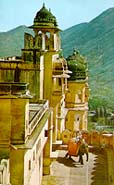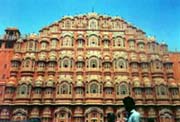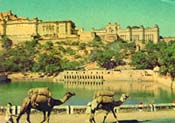Rajasthan- The land of princes...of legends... of glory...
Travelling through Rajasthan, visitors find the images of India they are searching for. In short, every visual cliche about India possible, other than the Taj Mahal... seen in 70 mm, in full glorious technicolour...
Anvar Alikhan
 Rajasthan, literally, means "The Land of the Princes", and it
is an appropriate name. For until just a few decades ago, this
region was a mosaic of little desert kingdoms, ruled over by a
glittering pageant of rajas and maharajas. They, and their Rajput
people, belonged to a warrior class that traced their ancestry
back to the sun and the moon.
Rajasthan, literally, means "The Land of the Princes", and it
is an appropriate name. For until just a few decades ago, this
region was a mosaic of little desert kingdoms, ruled over by a
glittering pageant of rajas and maharajas. They, and their Rajput
people, belonged to a warrior class that traced their ancestry
back to the sun and the moon.
And they were the inheritors of
a splendid tradition of valour, chivalry and martial prowess. Like
the knights of medieval Europe, the Rajputs were constantly riding
off into battle over matters of honour -- their own honour, their
clan's honour, their feudal lord's honour, or, best of all, the
honour of some exquisite almond-eyed desert princess. The history
of Rajasthan resounds with battles fought against impossible odds,
always ending in a glorious victory... or an even more glorious
defeat.
One little legend says it all: A Rajput prince, defeated
in battle by a vastly superior foe, returned to his castle, bloodied
and weary. He found the castle gates firmly shut upon him. And
as he stood outside, his wife, the queen, sent him a brief and
bitter message from within, "Why have you returned? Why did you
not die a noble death on the battlefield, as is expected of a
Rajput warrior?"

 In Rajasthan you can find traces of a civilization that flourished
here as far back as 4,500 years ago. However, it was in the 6th
to 7th centuries that this region really began to come to the
fore, with the formation of various Rajput warrior clans. In Rajasthan you can find traces of a civilization that flourished
here as far back as 4,500 years ago. However, it was in the 6th
to 7th centuries that this region really began to come to the
fore, with the formation of various Rajput warrior clans.
By the 12th century these clans had consolidated themselves into powerful
royal houses, which came into conflict with the Muslim invaders
from the northwest. In the mid-16th century, the Mughal emperor
Akbar, recognizing their power, formed a series of alliances with
almost all of the Rajput rulers and co-opted them into his army
as its main sword-arm.
It was a synergistic relationship, for
as a result, the Rajputs moved from being a regional power to
a subcontinental power, ranging across the length and breadth
of India at the head of the Mughal armies. In the 18th century,
the Rajputs went slowly into decline, partly as a result of internal
confusion, and partly as a result of external attacks from forces
like the Marathas.
Finally, between 1817 and 1823, the Rajput
states signed treaties of friendship with the British. After India's
independence in 1947, the princely states of the region were
 merged,
and ultimately formed into a single administrative unit that was
named Rajasthan. merged,
and ultimately formed into a single administrative unit that was
named Rajasthan.
|
There are innumerable such legends that live on today in the plaintive
songs of the wandering minstrels of Rajasthan. And in the great
medieval fortresses and palaces that dot the region, you can still
almost see and hear the cavalcade of history being replayed... the
clamour of battle, the whisper of intrigue, the tinkle of the
silver anklet bells of some long gone virgin princess. There are
perhaps few places in the world where history comes alive as palpably
and colourfully as it does in Rajasthan.
Yet, there is more to this region than its romantic "time warp" quality. For it is here that most travellers find the images
of India that they are truly searching for. Men in flamboyant
turbans and women in brilliantly coloured, swirling veils... Medieval
palaces delicately wrought with cupolas and archways... Vivid bazaars
where you can bargain for hand printed fabrics, jewellery, carpets...
Jungles where you can venture out in search of tigers or panthers...
Ancient temples intricately carved from marble or sandstone... caparisoned
elephants and peacocks that dance in the streets...
In short, every visual cliche possible about India, other than the Taj Mahal;
which itself is only a few hours drive away. No wonder, then, that virtually
every Hollywood film team that comes to India ends up shooting
most of its movie here in Rajasthan. It is the India of the fables,
seen in 70 mm, in full glorious technicolour.
Jaipur
 Jaipur is the capital of Rajasthan, and it is known as the Pink
City, for by law every building in the city's old quarter must
be repainted a deep saffron pink each year. This shade of pink
interplays with a rainbow of other spectacular colours, notably
the scarlet, bright orange and turmeric yellow of the
flowing costumes of the womenfolk and the men's proud turbans. It is, if nothing
else, an extraordinarily colourful city. Jaipur is the capital of Rajasthan, and it is known as the Pink
City, for by law every building in the city's old quarter must
be repainted a deep saffron pink each year. This shade of pink
interplays with a rainbow of other spectacular colours, notably
the scarlet, bright orange and turmeric yellow of the
flowing costumes of the womenfolk and the men's proud turbans. It is, if nothing
else, an extraordinarily colourful city.
 The population of Rajasthan, according to the 1991 census, is 43.9
million. However, what is significant is the low density of population
within the state, which is, in fact, one of the lowest in India.
Because of the harsh geographic conditions, the average density
of population is
The population of Rajasthan, according to the 1991 census, is 43.9
million. However, what is significant is the low density of population
within the state, which is, in fact, one of the lowest in India.
Because of the harsh geographic conditions, the average density
of population is  128 persons per square kilometre, and the figure
goes down to just nine persons per square kilometre is Jaisalmer
district! 128 persons per square kilometre, and the figure
goes down to just nine persons per square kilometre is Jaisalmer
district!
The population of Rajasthan is made up of a number of
communities, but the single most influential community has historically
been the Rajputs, who have deeply influenced the rest of society
with their own cultural values and martial spirit and chivalry.
 Another interesting feature of Rajasthan's population is the relatively
large proportion of tribals, who account for over 12 percent,
and who have their own distinctive ethnographic ways. The two
largest tribes are the Bhils of southern Rajasthan and the Minas
;of north-central Rajasthan. Another interesting feature of Rajasthan's population is the relatively
large proportion of tribals, who account for over 12 percent,
and who have their own distinctive ethnographic ways. The two
largest tribes are the Bhils of southern Rajasthan and the Minas
;of north-central Rajasthan.
|
The city was created in the 1720s by Maharaja Sawai Jai Singh
II, an eclectic combination of warrior, statesman, mathematician,
astronomer and architect. It was a remarkably well planned city,
laid out in a scientific grid system based on the ancient Sanskrit
treatise, the Shilpa Shastra. The roads were broad and intersected
each other with geometric precision, leading Rudyard Kipling to
note in 1899 that "many years afterward, the good people of America
builded their towns after this fashion.... (and) took all the
credit themselves".
Each trade or craft had a designated street.
Thus there was the street of the jewellers, the street of the candy makers,
a street of moneylenders, and so forth, all of which are still
functional today.
The Old City
The old city of Jaipur was designed around the concept of nine
architectural blocks, symbolising the nine planets of the universe.
And two of these blocks were devoted to the Maharaja's own palace.
This is today called the City Palace, and it's a sprawling complex
of courtyards, pavilions and halls, set in a formal Rajput-Mughal hybrid
style.
The scale and conception of the palace gives you some idea
of the power and wealth of the old maharajas, while the collection
of royal heirlooms on display in the palace museum fill in the
details of their lifestyle: sumptuous brocade robes, bloodthirsty
and bizarre weaponry, priceless miniature paintings and illuminated
manuscripts, and even, in one pavilion, two five-foot-high, solid
silver holy water urns, listed in the Guinness Book of World Records
as the largest silver objects in the world.
Adjacent to the City Palace is Maharaja Jai Singh II's amazing
18th century observatory, Jantar Mantar, with is strange instruments, shaped like
gigantic, abstract, futuristic sculptures, measuring up to 89
feet high and 148 feet wide, and still marking time accurate up
to 1 second!
Beyond Jantar Mantar begin Jaipur's colourful bazaars, where you
can browse for Rajasthan's famed hand-printed cotton fabrics,
meenakari enamel jewellery, camel skin mojri slippers with traditional
upturned toes, or attars, crushed from roses, jasmine, musk or
a variety of other exotic substances.
Amber and Jaigarh Forts
 Seven miles northeast of Jaipur lies the 16th century Amber Fort (see the picture at the left and at the top of the article; pictures are enlargable)
silently brooding in a valley protected by craggy, lion-coloured
hills. The fort is surrounded by mile upon mile of ramparts that
snake across the hills, punctuated by massive bastions and watchtowers. Seven miles northeast of Jaipur lies the 16th century Amber Fort (see the picture at the left and at the top of the article; pictures are enlargable)
silently brooding in a valley protected by craggy, lion-coloured
hills. The fort is surrounded by mile upon mile of ramparts that
snake across the hills, punctuated by massive bastions and watchtowers.
But once inside the fortified gates, you discover, to your surprise,
a complex of delicate pleasure palaces and formal gardens, set
with pools, fountains and water channels. It is a palace haunted
by centuries of legends, "a living palace" as Rudyard Kipling
put it, "where the sightseer knows and feels that... he is being
followed by scores of unseen eyes". The palace's Sukh Mandir chamber
has an ingenious medieval "air conditioning" system that cooled
the maharajas by amplifying the hill breezes and passing them
over channels of perfumed water.
But Amber's piece de resistance is the Sheesh Mahal chamber, its
walls literally ablaze with an intricately patterned mosaic of
mirror-work and coloured glass. When a single candle is lit
in the darkness here it creates a magical and infinite starscape
of reflected pinpoints of light.
In the looming hills above Amber is the mysterious fort of Jaigarh,
which formed part of Amber's complex defence system. Until just
a few years ago, Jaigarh was closed to the outside world --except
to the Maharaja's immediate family -- and guarded by a tribe of
fierce Mina archers. This element of secrecy gave rise to a number
of legends, chief among which is the legend of Raja Man Singh's
fabulous 15th century treasure, currently worth an estimated US $1.5
billion, which is said to be buried somewhere within these walls.
Some years ago, one of the world's most ambitious treasure
hunts was carried out here, although nothing was ever found. Jaigarh
Fort obviously guards its secrets exceedingly well.
While
you may not see any traces of this treasure, you'll certainly
see something else that is remarkable -- the 16th century Jaivana
cannon, the largest of its kind in the world, 20 feet long, 9
feet high, and so heavy that it needed four elephants to swivel
it around on its axis. At the village of Chaksu, nearly 30 miles
south of here, you are shown a spring of water which is said to
have gushed out of the earth on the impact of one of Jaivana's
mighty cannonballs!
Udaipur
Udaipur is one of the most picturesque and romantic cities in
India, built as it is around three lakes and surrounded by an
amphitheatre of low hills. On and around these lakes, the maharanas
of Udaipur built a series of beautiful palaces. As a result, when
the celebrated 19th century French traveller, Louis Rousselet, visited the city, he described it thus, "I stood in ecstasy, gazing at the sublime panorama spread out at my feet... it resembled one of the fairy cities in the Arabian Nights." |

